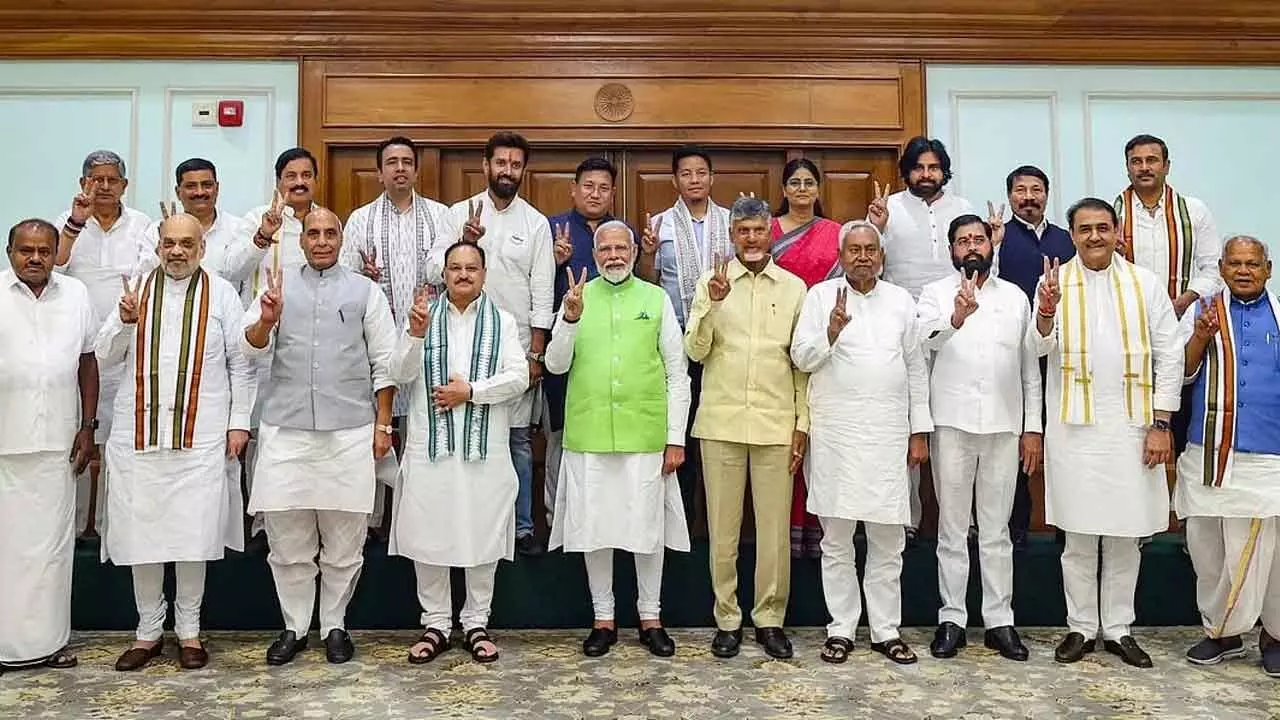Live
- Two drown as Indian Navy speedboat rams into passenger ferry in Arabian Sea off Gateway of India
- RG Kar tragedy trial: Recording of statements by 50 witnesses completed
- New expressway links Lhasa with birthplace of Tibetan civilization
- 13 Dead as Ferry Capsizes Near Gateway of India; Over 100 Rescued
- PM Modi to Visit Kuwait for Two Days from December 21, First Indian PM Visit in 43 Years
- Realme 14x with Rainwater Smart Touch Launched in India, Priced Starting at Rs 14,999
- Lanka T10 Super League: Jaffna Titans beat Hambantota Bangla Tigers in Qualifier 1, reach final
- Elon Musk Rejects Claims of Starlink Usage in Manipur Amid Growing Scrutiny Over SpaceX Compliance
- Bail Granted to Accused in Lagacharla Case by Nampally Special Court
- Indonesia to launch B40 biodiesel in 2025
Just In
Rural slowdown a major post-poll challenge for NDA


The Bharatiya Janata Party (BJP) has for long been perceived as an urban-centric party, going by the trend of voting in rural areas over the years....
The Bharatiya Janata Party (BJP) has for long been perceived as an urban-centric party, going by the trend of voting in rural areas over the years. The General Elections this year also lend credence to this perception. Though Narendra Modi-led government won a record third consecutive term, the BJP was 32 short of the halfway mark of 272 seats in Lok Sabha, with the result that it has to depend on its allies TDP and JD(U) to keep power in the face of a much lesser lead over the Opposition. This was a huge letdown for a party whose stalwarts claimed the party would win 370 seats on its own and cross the 400 mark with support of allies.
Analysts pored over the trends of voting and it became clear that the BJP suffered erosion of its vote in rural areas and even semi-urban areas, that too in the Hindi heartland. A reason for this loss, data shows, was distress in rural India, which the NDA had won over during the last two terms. The hinterland seemed to be sore that the Narendra Modi government did not create not much jobs for their youth, failed to rein in inflation, went back on promises of welfare to the farmersand marginalised sections.
However, the saffron party has much to cheer of late, as it has won Haryana for the third consecutive, beating the exit polls which unanimously predicted the rout for the party. Poll strategies apart, the general public, more so in rural areas, voted for its performance.
Adding to its joy even further are the latest findings by NABARD brought out in its second All India Rural Financial Inclusion Survey (NAFIS) for 2021-22, based on a survey of one lakh rural households of various economic and financial indicators in the post-COVID period. It pointed to rise in various economic parameters, such as household income, average monthly expenditure, use of Kisan Credit Card, household insurance coverage, pension coverage, financial literacy, and savings, too. The survey found that the rural households on an average saw their income surge by as much as 58% over the last five years, increasing from ₹8,059 in 2016-17 to ₹12,698 in 2021-22. Agricultural households accounted for average monthly earnings at ₹13,661, as compared to ₹11,438 for non-agricultural households.
The Modi government can rightly claim that it was indeed a remarkable stride in rural financial inclusion that saw the incomes rise. If rural households have experienced notable improvements in income, savings, insurance coverage, and financial literacy, the government schemes had certainly been a major booster. An interesting indicator of the survey is a rise in savings. The annual average financial savings of households increased to Rs 13,209 in 2021-22 from Rs. 9,104 in 2016-17. Overall, 66% of households reported saving money in 2021-22, compared to 50.6% in 2016-17. Agricultural households outperformed non-agricultural ones in terms of savings.
The result: While it retained Haryana, the BJP lost J&K, but secured the highest vote share in the state.
However, it must be said that the NDA government needs to take cognisance of the rural stagnancy for last two years. Food prices are still high and there’s not enough work for millions of youth, and households are struggling with the slowdown in rural India, notwithstanding the spectacular economic growth and prosperity of the urban India. India is among the countries that will face “serious obstacles” to come out of its middle income trap and become a high-income country in next few decades, as per a new World Bank report. Prosperity of rural India is the key and the government needs to lay more focus on rural distress and expedite rollout of what it pledged in the Union Budget 2024-25.

© 2024 Hyderabad Media House Limited/The Hans India. All rights reserved. Powered by hocalwire.com






